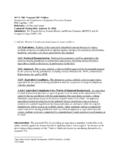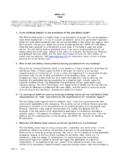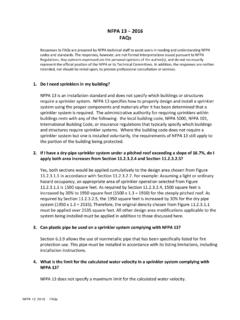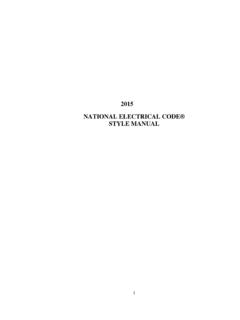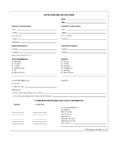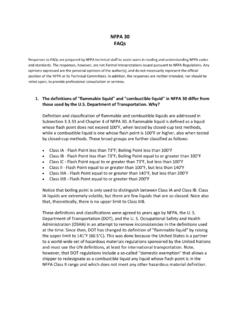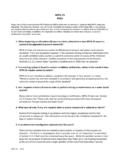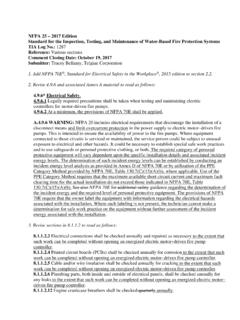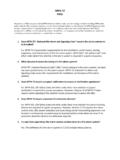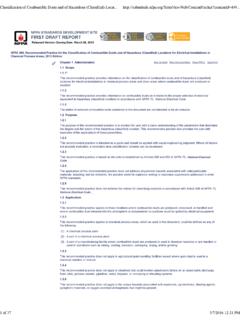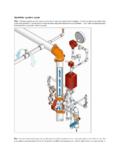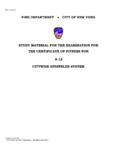Transcription of Installation of Sprinkler Systems - NFPA
1 DRAF TFOR COMMITTEEREVIEWC opyright 2012 National Fire Protection Association . All Rights 13 Standard for theInstallation of Sprinkler Systems2013 EditionThis edition of NFPA 13,Standard for the Installation of Sprinkler Systems , was prepared by theTechnical Committee on Hanging and Bracing of Water-Based Fire Protection Systems , Pri-vate Water Supply Piping Systems , Residential Sprinkler Systems , Sprinkler system DischargeCriteria, and Sprinkler system Installation Criteria and released by the Technical CorrelatingCommittee on Automatic Sprinkler Systems .
2 And acted on by NFPA at its June AssociationTechnical Meeting held June 8-11, 2009, in Chicago, IL. It was issued by the Standards Coun-cil on August 6, 2009, with an effective date of August 26, 2009, and supersedes all edition of NFPA 13 was approved as an American National Standard on August 26, and Development of NFPA 13 NFPA 13 represents the first standard published under the auspices of the NFPA Commit-tee on Automatic Sprinklers. Originally titledRules and Regulations of the National Board of FireUnderwriters for Sprinkler Equipments, Automatic and Open Systems , the standard has been continu-ously updated to keep in step with information about the NFPA actions on various changes will be found in the NFPAP roceedings.
3 The dates of successive editions are as follows: 1896, 1899, 1902, 1905, 1907,1908, 1912, 1913, 1915, 1916, 1917, 1919, 1920, 1921, 1922, 1923, 1924, 1925, 1926, 1927,1928, 1929. In 1930, a separate standard was published on Class B Systems . This was integratedinto the 1931 edition. Further revisions were adopted in 1934, 1935, and 1936. A two-steprevision was presented in the form of a progress report in 1939 and finally adopted in amendments were made in 1947, 1950, 1953, 1956, 1958, 1960, 1961, 1963, 1964,1965, 1966, 1968, 1969, 1971, 1972, 1973, 1974, 1975, 1976, 1978, 1980, 1982, 1984, 1986, 1991 edition incorporated an entire rewrite of the standard to make the overallformat user friendly.
4 Substantive changes were made to numerous terms, definitions, anddescriptions, with additional refinements made in centennial (1996) edition included a significant rework of the requirements pertain-ing to the application, placement, location, spacing, and use of various types of changes provided information on extended coverage sprinklers and recognized thebenefits of fast-response Sprinkler 1999 edition encompassed a major reorganization of NFPA s Sprinkler Project thatincluded the establishment of a Technical Correlating Committee on Automatic SprinklerSystems and four new Sprinkler Systems technical committees.
5 The consolidation of NFPA ssprinkler system design and Installation requirements, and the implementation of numeroustechnical scope of NFPA 13 was expanded to address all Sprinkler system applications. The 1999edition contained information on the Installation of underground pipe from NFPA 24 andsprinkler system discharge criteria for on-floor and rack storage of Class I, II, III, IV, andplastic commodities, rubber tires, baled cotton, and roll paper that were previously located inNFPA 231, 231C, 231D, 231E, and 231F.
6 Additionally, Sprinkler system information for special-ized hazards from over 40 NFPA documents was either copied into NFPA 13 using NFPA sextract policy or specifically referenced. A new chapter was also added to address the struc-tural aspects of exposed and buried system piping. A table of cross-references to previouseditions and material that was located in other NFPA documents was included at the end ofthe 1999 1 NFPA and National Fire Protection Association are registered trademarks of the National Fire Protection Association, Quincy, Massachusetts TFOR COMMITTEEREVIEWMore specific changes included a new Sprinkler identification marking system and the designation of Sprinkler sizesby nominal K-factors.
7 New criteria for the use of steel pipe in underground applications was added, as well as a newprovision to guard against microbiologically influenced corrosion. Obstruction rules for specific Sprinkler types andrules for locating sprinklers in concealed spaces were revised. New limitations were placed on the Sprinkler sizes instorage applications, and criteria for the K-25 Sprinkler was added. Additionally, the requirements for protectingsprinklers against seismic events also underwent significant 2002 edition of NFPA 13 underwent style formatting and technical revisions.
8 The style formatting was com-pleted to comply with theManual of Style for NFPA Technical Committee Documentsand to reorganize many of the require-ments in NFPA 13 into unique chapters. Editorially, NFPA 13 eliminated all of the exceptions and reworded them asrequirements where applicable, moved the mandatory references to Chapter 2, and relocated all of the definitions toChapter 3. In reorganizing NFPA 13, several new chapters were created to consolidate requirements including thefollowing: Chapter 10 contained all of the applicable requirements for underground piping including materials, Installation , and acceptance testing; Chapter 11 contained design approaches including pipe schedule, density/areamethod, room design method, special design areas, residential sprinklers, exposure protection, and water curtains.
9 Chapter 12 contained the design approaches for the protection of storage, including idle pallets, miscellaneousstorage, storage less than 12 ft, palletized, solid pile, bin box, and shelf storage, rack storage less than 25 ft, rack storagegreater than 25 ft, rubber tire, baled cotton, rolled paper, and special storage designs; Chapter 13 contained all of thedesign and Installation requirements from all of the various documents that have been extracted into NFPA 2002 edition made specific technical changes to address several key issues.
10 Three major areas of irregularceiling were addressed, including skylights, stepped ceilings, and ceiling pockets. The design requirements for ESFR sprinklers were expanded to allow the user to choose the storage height and then the building height for any allowablearrangement. Design requirements for the protection of storage on solid shelves were added. Requirements for theinstallation of residential sprinklers were added that parallel the requirements for other types of the 2007 edition, definitions were reorganized to locate all of the storage definitions in one area, and severalnew definitions addressing private water supply terms were added.
